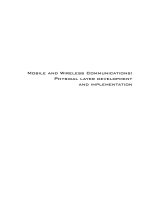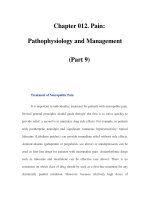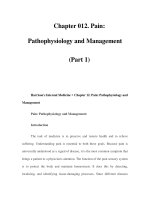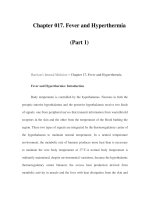Chapter 044. Abdominal Swelling and Ascites (Part 1) docx
Bạn đang xem bản rút gọn của tài liệu. Xem và tải ngay bản đầy đủ của tài liệu tại đây (13.75 KB, 5 trang )
Chapter 044. Abdominal
Swelling and Ascites
(Part 1)
Harrison's Internal Medicine > Chapter 44. Abdominal Swelling and
Ascites
Abdominal Swelling
Abdominal swelling or distention is a common problem in clinical
medicine and may be the initial manifestation of a systemic disease or of
otherwise unsuspected abdominal disease. Subjective abdominal enlargement,
often described as a sensation of fullness or bloating, is usually transient and is
often related to a functional gastrointestinal disorder when it is not accompanied
by objective physical findings of increased abdominal girth or local swelling.
Obesity and lumbar lordosis, which may be associated with prominence of the
abdomen, may usually be distinguished from true increases in the volume of the
peritoneal cavity by history and careful physical examination.
Clinical History
Abdominal swelling may first be noticed by the patient because of a
progressive increase in belt or clothing size, the appearance of abdominal or
inguinal hernias, or the development of a localized swelling. Often, considerable
abdominal enlargement has gone unnoticed for weeks or months, either because of
coexistent obesity or because the ascites formation has been insidious, without
pain or localizing symptoms. Progressive abdominal distention may be associated
with a sensation of "pulling" or "stretching" of the flanks or groins and vague low
back pain. Localized pain usually results from involvement of an abdominal organ
(e.g., a passively congested liver, large spleen, or colonic tumor). Pain is
uncommon in cirrhosis with ascites, and when it is present, pancreatitis,
hepatocellular carcinoma, or peritonitis should be considered. Tense ascites or
abdominal tumors may produce increased intraabdominal pressure, resulting in
indigestion and heartburn due to gastroesophageal reflux or dyspnea, abdominal
wall hernias (inguinal and umbilical), orthopnea, and tachypnea from elevation of
the diaphragm. A coexistent pleural effusion, more commonly on the right,
presumably due to leakage of ascitic fluid through lymphatic channels in the
diaphragm, may also contribute to respiratory embarrassment. A large pleural
effusion, obscuring most of the lung, is known as a hepatic hydrothorax. The
patient with diffuse abdominal swelling should be questioned about increased
alcohol intake, a prior episode of jaundice or hematuria, or a change in bowel
habits. Such historic information may provide the clues that will lead one to
suspect an occult cirrhosis, a colonic tumor with peritoneal seeding, congestive
heart failure, or nephrosis.
Approach to the Patient: Abdominal Swelling
A carefully executed general physical examination can yield valuable clues
concerning the etiology of abdominal swelling. Thus palmar erythema and spider
angiomas suggest an underlying cirrhosis, while supraclavicular adenopathy
(Virchow's node) should raise the question of an underlying gastrointestinal
malignancy.
Inspection of the abdomen is important. By noting the abdominal contour,
one may be able to distinguish localized from generalized swelling. The tensely
distended abdomen with tightly stretched skin, bulging flanks, and everted
umbilicus is characteristic of ascites. A prominent abdominal venous pattern with
the direction of flow away from the umbilicus is often a reflection of portal
hypertension; venous collaterals with flow from the lower part of the abdomen
toward the umbilicus suggest obstruction of the inferior vena cava; flow
downward toward the umbilicus suggests superior vena cava obstruction.
"Doming" of the abdomen with visible ridges from underlying intestinal loops is
usually due to intestinal obstruction or distention. An epigastric mass, with evident
peristalsis proceeding from left to right, usually indicates underlying pyloric
obstruction. A liver with metastatic deposits may be visible as a nodular right
upper quadrant mass moving with respiration.
Auscultation may reveal the high-pitched, rushing sounds of early intestinal
obstruction or a succussion sound due to increased fluid and gas in a dilated
hollow viscus. Careful auscultation over an enlarged liver occasionally reveals a
harsh bruit signifying a vascular tumor (especially a hepatocellular carcinoma) or
alcoholic hepatitis, or the leathery friction rub of a surface nodule. A venous hum
at the umbilicus may signify portal hypertension and an increased collateral blood
flow around the liver. A fluid wave and flank dullness that shifts with change in
position of the patient are important signs that indicate the presence of peritoneal
fluid, although a minimum of 1500 mL of fluid is usually required to produce
these findings. In obese patients, small amounts of fluid may be difficult to
demonstrate and often can only be detected by ultrasound examination of the
abdomen, which can detect as little as 100 mL of fluid. Careful percussion should
serve to distinguish generalized abdominal enlargement from localized swelling
due to an enlarged uterus, ovarian cyst, or distended bladder. Percussion can also
outline an abnormally small or large liver. Loss of normal liver dullness may result
from massive hepatic necrosis; it also may be a clue to free gas in the peritoneal
cavity, as from perforation of a hollow viscus.









